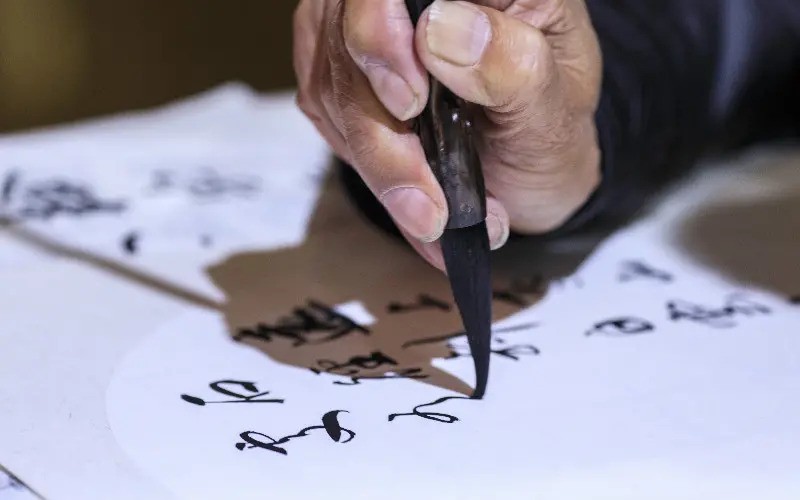By Janet Tse
Janet Tse has 25 years of teaching experience and over 30 years participation in environmental protection, along with practicing and coaching mindfulness meditation. Her qualifications include a Master of Buddhist Studies (MBS, HKU), Master of Business Administration (MBA, HKBU), Certificate in MEDPAC Drug Abuse Quitline (HKU), Mental Health First Aid (MHFA) International / Hong Kong, and Nature Dao Elementary Tutor Training.
Buddhist calligraphy has been a significant meditation practice in Chan Buddhism since the Sui and Tang Dynasties. Today, it is renowned for its ability to generate inner peace, tranquility and concentration.
Buddhism has been integrated within Chinese culture for centuries and its relationship with calligraphy can never be neglected. Meditation, monastic cultures, and Buddhist calligraphy have an inseparable relationship. The human-calligraphy unity, “ren shu he yi 人書合一,” is manifest in the masters. In fact, Chinese calligraphy requires quiet observation and concentration. From ancient to modern times in China, Japan, Taiwan, Vietnam, Bangkok and other regions, monastic calligraphy is “down-to-earth,” practical Zen-in-action. For instance, Huaisu (懷素), Zen Master Zhiyong (智永禪師), Daya (大雅), Huairen (懷仁), Guan Xiu (貫休), and Hong Yi (弘一) were eminent monks that introduced calligraphy to Zen or vice versa.
Stress among Hong Kong people during COVID has been reported by various studies and research. Around 50 per cent of Hongkongers suffered stress, depression, or severe anxiety during the pandemic, with many requiring professional emotional support. Complementary therapies for stress relief, such as art therapy, have been widely used and various experiments have been conducted.
But rarely has research been conducted on Buddhist calligraphy as an alternative in relieving stress. This is despite the fact that Chinese calligraphy has been deemed to be an effective tool to improve emotional calmness and relaxation.

Calligraphy has an inseparable relationship with Buddhism, especially in regard to Chan practice in China, Japan and other countries. It is still regarded as a fringe form of alternative therapy. In Hong Kong, a research project aimed at investigating the relationship between Buddhist calligraphy and the relief of stress during COVID was conducted from April to July 2023.
The survey
Participants in Hong Kong aged over 18 were invited to report psychological and behavioral data and other information through a quantitative research and a qualitative survey. First of all, ten volunteer calligraphers were invited to conduct personal telephone interviews and case studies. Through these, interviewees were more willing to express in detail their personal feelings and situations regarding the relationships and differences from practicing calligraphy, with or without Buddhist sutras.
During the interviews, three interviewees (30 per cent) clearly stated that through practicing Chinese calligraphy, they could calm themselves, and were more concentrated and focused on the present moment without worries or being upset. Furthermore, two of them (20 per cent) reported that greater calmness and focus could be achieved when practicing Buddhist calligraphy. Nine (90 per cent) agreed that practicing calligraphy with Buddhist scriptures and Buddhist words relieved stress, and led to increased concentration and emotional calmness amidst their life problems.
Four (40 per cent) reported that their minds and thoughts would connect with the Buddhist teachings whilst practicing calligraphy with Buddhist content, setting their minds at ease and easing grief or sorrow. Four (40 per cent) Chinese calligraphy teachers and one (10 per cent) calligrapher reported that their intentions were primarily in pursuit of, and dedicated to, the qualities of calligraphy’s aesthetic beauty. They were hoping to experience satisfaction and self-actualization, reaching “no-self” in arts, and reported indifference to distinctions between Chinese and Buddhist calligraphy.

Moreover, a Christian interviewee reported having severe insomnia, especially during a difficult period of heartbreak. Only through practicing Buddhist calligraphy with the Diamond Sutra could calm their mind during this difficult period. Interestingly, this outcome could not be achieved when practised Chinese calligraphy with non-Buddhist-themed characters. The primary reason for this is that words and sentences are quite similar in the Diamond Sutra, resulting in the writer being more prone to making mistakes. Therefore, practicing calligraphy with Diamond Sutra requires a relatively high degree of concentration and equanimity. Another Christian interviewee reported thoughts of suicide caused by serious and stressful relationships with their boss, work colleagues, and family members. However, such thoughts vanished during and after practicing calligraphy and painting.
All in all, a highlight from the telephone or personal interviews is that even those of Christian faith confirmed that Buddhist calligraphy can be an effective tool in improving concentration and equanimity; and, eliminating negative emotions.
According to this research project’s results, when we need more tranquility and peace during a chaotic and uncertain period like the pandemic, Buddhist calligraphy can be an effective tool for mental training or mindfulness meditation. The improvements in relaxation, inner peace, concentration, enjoyment, happiness and emotional stability are well observed through practicing Buddhist calligraphy.


